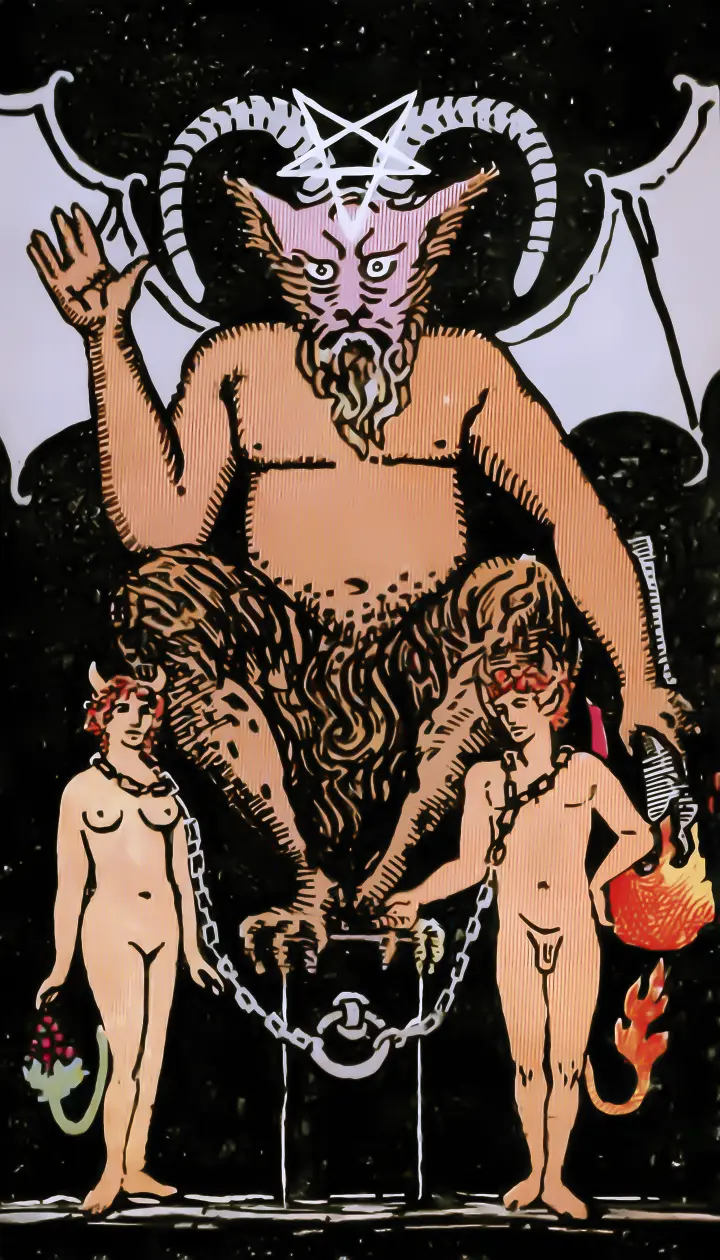
The Devil Card Fully Explained
By DivinationToolThe Devil card represents bondage, temptation, and primal desire. This article explores both upright and reversed meanings of The Devil card, shedding light on its profound lessons about self-awareness, instincts, and liberation.
The Devil Card Fully Explained | Desire, Bondage, and Awakening
Associated Information
Related Words: Bondage and Desire Astrological Correspondence: Capricorn Element: Earth
Key Words
Tempting, illicit, improper, desirous, unworldly, indignant, repressive, restrictive, passive, fearful, dark, depressed.
Upright Interpretation
Illicit love affair, improper desires, being tempted, violating social conventions, immoral behavior, exceptional artistic talent, immersion in negativity, trapped in fear, filled with anger and resentment, self-hindrance due to fear, wrong direction, disloyalty, secret romance.
Reversed Interpretation
Liberation from an illicit affair, breaking free from worldly shackles, disregarding morality, escapism, self-harm, dissolution of desire, cursed, overwhelming desires, unfavorable environment, blind judgment, being despised.
The Devil card reversed may signify the imminent removal of shackles, no longer being bound, and escaping relationships based on power dynamics. Removing the shackles also implies no longer being restricted, ceasing self-deception, and gradually seeing reality clearly. However, there is another interpretation: when the Devil is reversed, one might fail to perceive the Devil clearly. The Devil subtly controls people, making them driven by impulses and unable to restrain themselves.
Detailed Meaning of the Card
The Devil never conceals his wicked power. Wherever he appears, he reveals improper desires.
The pentagram on the Devil’s head symbolizes the force of evil. With his mouth wide open and a deep, seductive laugh, he tempts men and women to cross the boundaries of morality. The improper desires within people’s hearts drive them toward the wrong direction; once they have strayed for too long, their free will weakens, and they inevitably fall under the Devil’s control. Eventually, they may turn into demons themselves, unable to return to the heavens, forever bound to darkness. The chains on the figures represent the controlled human nature and restricted actions, symbolizing the price of downfall.
The Devil is formed from primitive biological instincts (his image composed of goats, bats, apes, birds, and other animals). Some may belittle this card, seeing it as purely negative because, from an ethical perspective, the thoughts generated by the Devil are considered evil and degenerate. However, everyone harbors primal instincts. Humans come from nature, born of the earth, and naturally retain traces of these original biological impulses. The more one resists the Devil's forces, the harder it becomes to manage one’s own situation. Moreover, the Devil also has a constructive side: he aids in reproduction and the continuation of the human race.
The corresponding aspects of the Devil may include biological functions like the endocrine system and hormones, representing biological needs such as reproduction, hunger, and food consumption. On a psychological level, it may represent the needs for sexual pleasure, enjoyment, wealth, and power—forces that drive human desires. Because of desire, supply and demand flourish, leading to the prosperity and complexity of human society.
How does the image of the Devil emerge? Besides primitive instincts, it may also arise from human desires themselves. Strong desires seem to possess their own vitality, controlling our actions. Human craving and yearning, the constant urge to satisfy desires, can lead one to become enslaved by obsession. The Devil undoubtedly possesses creativity: from a pragmatic perspective, he demands an exchange, just like the torch in his hand, requiring a price to be paid. For example, in work situations, under the influence of the Devil, one may become trapped, pouring all their life energy into it, burning themselves out—yet in exchange, gaining money or career advancement.
In romantic relationships, the Devil often involves sexual elements, focusing on the most basic level of emotional redemption: physical gratification. Here, the Devil becomes a curse, binding two people together through sex and desire. However, in a constructive, loving relationship, the Devil’s primal forces are elevated and merged between the two partners, resulting in ecstatic joy and physical intimacy.
The iron chains binding the two figures symbolize entanglement. In a relationship, both parties may attempt to maintain the bond through money, sex, or power, manifested through seduction, temptation, and flattery, or willingly entangling themselves for the sake of obtaining these things. However, the individuals involved may not even be aware of it, never having questioned their own motives. From an outsider’s perspective, they may seem obsessed and lost, remaining in the relationship solely for a certain purpose.